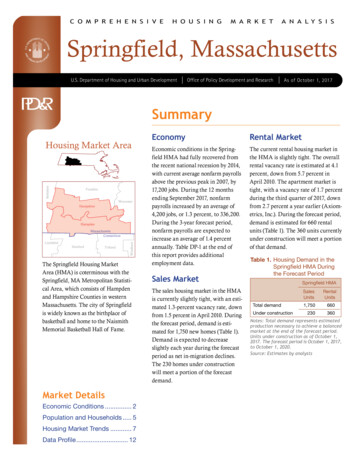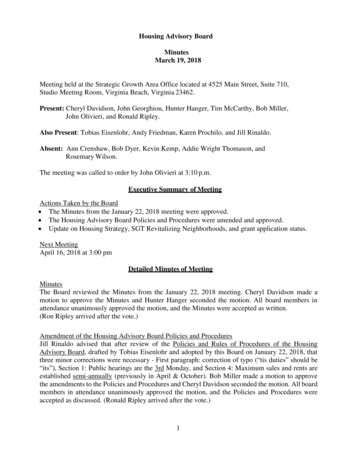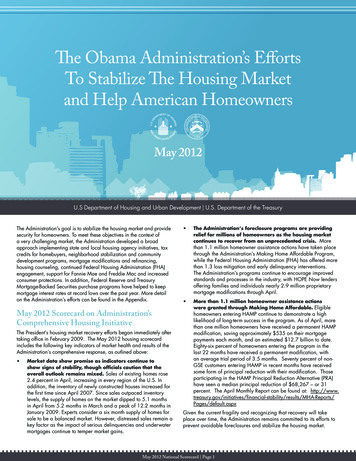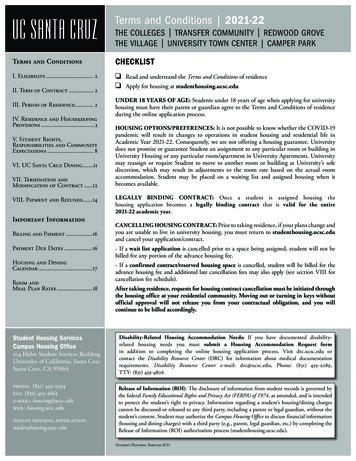
Transcription
C O M P R E H E N S I V EH O U S I N GM A R K E TA N A L Y S I SSpringfield, MassachusettsU.S. Department of Housing and Urban DevelopmentOffice of Policy Development and ResearchAs of October 1, 2017SummaryBerkshireHousing Market tfordTollandWindhamMassachusettsConnecticutThe Springfield Housing MarketArea (HMA) is coterminous with theSpringfield, MA Metropolitan Statistical Area, which consists of Hampdenand Hampshire Counties in westernMassachusetts. The city of Springfieldis widely known as the birthplace ofbasketball and home to the NaismithMemorial Basketball Hall of Fame.Market DetailsEconomic Conditions. 2Population and Households. 5Housing Market Trends. 7Data Profile. 12EconomyRental MarketEconomic conditions in the Springfield HMA had fully recovered fromthe recent national recession by 2014,with current average nonfarm payrollsabove the previous peak in 2007, by17,200 jobs. During the 12 monthsending September 2017, nonfarmpayrolls increased by an average of4,200 jobs, or 1.3 percent, to 336,200.During the 3-year forecast period,nonfarm payrolls are expected toincrease an average of 1.4 percentannually. Table DP-1 at the end ofthis report provides additionalemployment data.The current rental housing market inthe HMA is slightly tight. The overallrental vacancy rate is estimated at 4.1percent, down from 5.7 percent inApril 2010. The apartment market istight, with a vacancy rate of 1.7 percentduring the third quarter of 2017, downfrom 2.7 percent a year earlier (Axiometrics, Inc.). During the forecast period,demand is estimated for 660 rentalunits (Table 1). The 360 units currentlyunder construction will meet a portionof that demand.Sales MarketThe sales housing market in the HMAis currently slightly tight, with an estimated 1.3-percent vacancy rate, downfrom 1.5 percent in April 2010. Duringthe forecast period, demand is esti mated for 1,750 new homes (Table 1).Demand is expected to decreaseslightly each year during the forecastperiod as net in-migration declines.The 230 homes under constructionwill meet a portion of the forecastdemand.Table 1. Housing Demand in theSpringfield HMA Duringthe Forecast PeriodSpringfield HMATotal demandUnder es: Total demand represents estimatedproduction necessary to achieve a balancedmarket at the end of the forecast period.Units under construction as of October 1,2017. The forecast period is October 1, 2017,to October 1, 2020.Source: Estimates by analysts
2Economic ConditionsS p r i n g f i e l d , M A C O M P R E H E N S I V E H O U S I N G M A R K E T A N A LY S I SIn the following discussion, alldata relate to the SpringfieldHMA except for nonfarm payrolldata, which are available from theU.S. Bureau of Labor Statistics forthe Springfield, MA MetropolitanNew England City and Town Area(hereafter, Springfield NECTA).The Springfield NECTA, which isgeographically similar to the Springfield HMA, contains all the majoremployment and population centersin the HMA.The economy of the SpringfieldHMA, beginning with the opening ofthe National Armory at Springfield in1777 by George Washington, was historically based on manufacturing. Theclosing of the Armory in 1968, alongwith a general trend of decliningmanufacturing employment, limitedjob growth in the region during thelatter half of the 20th century throughthe 1990s. The HMA also developedas a center of higher educationbegin ning in the late 19th century.Numerous institutions of higherlearning are in the HMA—includingtwo of the “Seven Sisters” colleges,Mount Holyoke and Smith Colleges,traditionally all-female institutionsof higher learning, along with theflagship campus of the University ofMassachusetts (UMass) in Amherst.In 2015, UMass Amherst generated 2.1 billion in economic activitythroughout Massachusetts (UMassDonahue Institute).From 2000 through 2010, job growthwas limited in the Springfield NECTA,as the continued decline in manufacturing employment offset job growthin the education and health servicessector. In 2000, nonfarm payrollstotaled 314,300 jobs, as the HMAwas nearing the end of an expansion during the late 1990s. In 2000,manufacturing sector jobs accountedfor 15 percent of all nonfarm payrollsector jobs, down from nearly 20 per cent in 1990. During 2001, nonfarmpayrolls increased by 2,400 jobs, or0.8 percent, mainly because of anexpansion of the education and healthservices sector by 2,400 jobs, or 4.8percent. Subsequently, nonfarm pay rolls declined during the next 2 yearsand, by 2003, totaled 312,200 jobs,an average decline of 2,300, or 0.7percent, annually. Job losses duringthe period were mainly due to themanufacturing sector declining by anaverage of 2,800 jobs, or 6.5 percent,annually. The number of jobs beganto increase again during 2004, andby 2007, nonfarm payrolls totaled319,000 jobs, an average increase of1,700, or 0.5 percent, annually. Theeducation and health services sector,which increased by an average of1,400 jobs, or 2.4 percent, annually,led job growth. It was during thisperiod that the education and healthservices sector became the largest pay roll sector in the HMA, accountingfor 20 percent of all nonfarm payrolljobs in 2007. Manufacturing job lossescontinued from 2004 through 2007by an average of 700 jobs, or 1.9percent, annually. With the onset ofthe 2007–2009 national recession,nonfarm payrolls declined during2008 and 2009 by an average of5,600 jobs, or 1.8 percent, annually.Job losses were greatest in the manu facturing sector, declining by 2,300jobs, or 6.3 percent, annually. Joblosses in the manufacturing sectorduring the period included about 200jobs at Hasbro, Inc. in early 2008. Bythe end of 2009, the proportion ofnonfarm payrolls in the manufacturing sector was down to 10.5 percent.During 2010, nonfarm payrolls beganto expand once more and, by 2015,
Economic Conditions Continuedtotaled 329,000 jobs, an averagein crease of 3,500, or 1.1 percent,annu ally. During these years, theeducation and health services sector,which expanded by an average of1,800 jobs, or 2.5 percent, annually,led job growth, due in part to BaystateHealth System’s 296 million expansion of Baystate Medical Center thatcreated about 550 jobs in 2012.Economic conditions in the HMA remained positive in the past 12 months,with continued job growth and adeclining unemployment rate. Duringthe 12 months ending September 2017,nonfarm payrolls rose in the Spring fieldNECTA by 4,200 jobs, or 1.3 percent,Table 2. 12-Month Average Nonfarm Payroll Jobs in the SpringfieldNECTA, by Sector12 Months EndingTotal nonfarm payroll jobsGoods-producing sectorsMining, logging, & constructionManufacturingService-providing sectorsWholesale & retail tradeTransportation & utilitiesInformationFinancial activitiesProfessional & business servicesEducation & health servicesLeisure & hospitalityOther 00– 4004,100900100– 100– 2008002,100– 9002001,1001.30.55.5– 1.41.41.90.7– 2.9– 1.23.02.7– 2.91.61.7Notes: Numbers may not add to totals because of rounding. Based on 12-monthaverages through September 2016 and September 2017. Nonfarm payroll jobs data arefor the Springfield, MA Metropolitan New England City and Town Area (NECTA).Source: U.S. Bureau of Labor Statistics2.0245,0000.02020200200200200Labor 5,000Resident employmentSource: U.S. Bureau of Labor StatisticsUnemployment rateUnemployment rateFigure 1. T rends in Labor Force, Resident Employment, and Unemployment Rate in the Springfield HMA, 2000 Through 2016Labor force andresident employmentS p r i n g f i e l d , M A C O M P R E H E N S I V E H O U S I N G M A R K E T A N A LY S I S3to 336,200 (Table 2). This growth ratewas similar to the previous 12 months.The unemployment rate in the HMAaveraged 4.6 percent during the 12months ending September 2017, downfrom 5.0 percent during the sameperiod a year earlier. By comparison,the unemployment rate had a recentpeak of 9.4 in 2010 and averaged4.9 percent from 2000 through 2007(Figure 1).One of the factors contributing to therecent job growth in the SpringfieldNECTA has been several large-scaleconstruction projects, including the 950 million MGM Springfield casinothat is expected to open in 2018 andthe 94 million rehabilitation of UnionStation in the city of Springfield thatreopened in June 2017. Because ofthe construction jobs at these projects,the mining, logging, and constructionsector had the largest percentage gainin jobs during the 12 months endingSeptember 2017, increasing 5.5 per cent, or by 600 jobs.The education and health servicessector led job growth during the 12months ending September 2017, in creasing by 2,100 jobs, or 2.7 percent,to 81,000. As the make-up of the localeconomy became less concentratedin manufacturing, the education andhealth services sector became the largestemployment sector, accounting for 24percent of all jobs in the SpringfieldNECTA (Figure 2). Of the 10 largestemployers in the HMA, 4 are in thissector: Baystate Health System, Sistersof Providence Health System, CooleyDickinson Hospital, and the Centerfor Human Development (Table 3).The education and health servicessector has been the fastest growingsector in the NECTA since 2000,with nonfarm payrolls in this sectorincreasing from 49,900 in 2000 to
4Economic Conditions ContinuedFigure 2. Current Nonfarm Payroll Jobs in the Springfield NECTA,by Sector81,000 currently, rising at an averageannual rate of 1,900 jobs, or 2.9 per cent (Figure 3).Mining, logging, & construction 3.4%Government 19.1%Manufacturing 8.5%Wholesale & retail trade 14.0%Other services 3.9%S p r i n g f i e l d , M A C O M P R E H E N S I V E H O U S I N G M A R K E T A N A LY S I SLeisure & hospitality 8.8%Transportation & utilities 4.0%Information 1.0%Financial activities 5.0%Professional & business services 8.1%Education & health services 24.1%Notes: Based on 12-month averages through September 2017. Nonfarm payrolljobs data are for the Springfield, MA Metropolitan New England City and TownArea (NECTA).Source: U.S. Bureau of Labor StatisticsTable 3. Major Employers in the Springfield HMAName of EmployerNonfarm Payroll SectorNumber ofEmployeesBaystate Health SystemUniversity of MassachusettsMassMutual Financial GroupBig Y Foods, Inc.Westover Air Reserve BaseSisters of Providence Health SystemCooley Dickinson HospitalWestfield State UniversityCenter for Human DevelopmentHolyoke Community CollegeEducation & health servicesGovernmentFinancial activitiesWholesale & retail tradeGovernmentEducation & health servicesEducation & health servicesGovernmentEducation & health 9251,5501,5001,500Notes: Excludes local school districts. Westover Air Reserve Base data includemilitary personnel, who are generally not included in nonfarm payroll survey data.Source: Business West Resource Guide 2016–2017The government sector is the secondlargest employment sector in theNECTA with 64,200 nonfarm payrolljobs. During the 12 months endingSeptember 2017, employment in thissector increased by 1,100 jobs, or 1.7percent. UMass Amherst has an en rollment of 28,800 students and is thesecond largest employer in the HMA,with 7,900 employees. The universityhad more than a 2 billon economic impact on the local economy during fiscalyear 2015 (UMass Dona hue Institute).Another major em ployer in this sectoris the Westover Air Reserve Base,which has 5,000 employees. This baseis the largest air reserve base in termsof area and was a backup landingsite for the National Aeronautics andSpace Administration, or NASA,space shuttle program.The professional and business servicessector also had strong growth duringFigure 3. Sector Growth in the Springfield NECTA, Percentage Change, 2000 to CurrentTotal nonfarm payroll jobsGoods-producing sectorsMining, logging, & constructionManufacturingService-providing sectorsWholesale & retail tradeTransportation & utilitiesInformationFinancial activitiesProfessional & business servicesEducation & health servicesLeisure & hospitalityOther servicesGovernment– 50– 40– 30– 20– 10010203040506070Notes: Current is based on 12-month averages through September 2017. Nonfarm payroll jobs data are for the Springfield, MAMetropolitan New England City and Town Area (NECTA). During this period, payrolls in the financial activities sector showed nonet change.Source: U.S. Bureau of Labor Statistics
5Economic Conditions ContinuedS p r i n g f i e l d , M A C O M P R E H E N S I V E H O U S I N G M A R K E T A N A LY S I Sthe 12 months ending September 2017,increasing by 800 jobs, or 3.0 percent,which was the largest percentage gainof any service-providing sector. Partof this job growth was due to theopening of Falvey Linen Supply inearly 2017 in the city of Springfield,which added 125 jobs.Although overall job growth is positive,some sectors of the economy lost jobsduring the 12 months ending September 2017. The leisure and hospitalitysector led job losses, declining by 900jobs, or 2.9 percent, partially due tothe closing of several hotels in theNECTA and reduced seasonal hiringby Six Flags New England. In thefinancial services sector, nonfarm pay rolls declined by 200, or 1.2 percent,in part, because of layoffs by MassMutual Financial Group following a 165 million acquisition. The manufacturing sector decreased by 400 jobs,or 1.4 percent, to 28,500 during the12 months ending September 2017. Incontrast to the education and healthservices sector, manufacturing sectorjobs have decreased nearly every yearsince 2000 from 48,200 to 28,500, falling by an average of 1,200 jobs,or 3.1 percent, annually. The manufacturing sector currently comprisesabout 9 per cent of nonfarm payrolljobs in the Springfield NECTA, downfrom 15 percent in 2000. Despite the joblosses in the sector, the Springfieldbased firearm manufacturer Smith& Wesson has expanded from 600employees in 2008 to about 1,480currently in the NECTA.The economic outlook for the HMAis positive, with nonfarm payrollsexpected to increase by an average of4,700, or 1.4 percent, annually duringthe 3-year forecast period. The opening of the MGM Springfield casinoin 2018 is expected to create nearly3,000 jobs in the leisure and hospitality sector. In addition, China RailroadRolling Stock Corporation is buildinga new 95 million facility in the cityof Springfield to manufacture railcars for subway systems, includingthe Massachusetts Bay TransportationAuthority and Los Angeles CountyMetropolitan Transportation Authority.Once fully operational in 2020, thefacility will employ 200 manufacturingworkers.Population and HouseholdsAs of October 1, 2017, thepopulation of the SpringfieldHMA is estimated at 630,400, anaverage annual increase of 0.2percent, or 1,175, since 2010. Thisgrowth rate is similar to the averageannual population growth of 1,300people, or 0.2 percent, from 2000 to2010. Despite similar populationgrowth rates, the components ofpopulation change differed in the twoperiods. Since 2010, net in-migrationhas averaged 360 annually, comprising 31 percent of overall populationgrowth, with the strongest netin-migration occurring early in thedecade. In contrast, from 2000 to2010, net in-migration averaged 25people annually, accounting for lessthan 2 percent of population growth.
Since 2000, net in-migration to theHMA has occurred during periods ofweak economic conditions nationwide, as economic prospects outsidethe HMA were scarce. In contrast,during periods of national economicgrowth, the HMA experienced netout-migration, in part, because peoplemoved to areas with better job oppor tunities. In the early part of the 2000s,population growth in the SpringfieldHMA averaged 3,100 people, or 0.5percent a year, from 2001 to 2003, thehighest rate of any period since 2000(U.S. Census Bureau populationesti mates as of July 1). The populationincrease during this period was largelybecause of net in-migration, whichaveraged 1,775 annually, despiteoccurring during a period of weakFigure 4. Components of Population Change in the SpringfieldHMA, 2000 to ForecastAverage annual change1,4001,2001,00080060040020002000 to 20102010 to currentNet natural changeCurrent to forecastNet migrationNotes: The current date is October 1, 2017. The forecast date is October 1, 2020.Sources: 2000 and 2010—2000 Census and 2010 Census; current and forecast—estimates by analystsFigure 5. Population and Household Growth in the SpringfieldHMA, 2000 to Forecast1,400Average annual changeS p r i n g f i e l d , M A C O M P R E H E N S I V E H O U S I N G M A R K E T A N A LY S I S6Population and Households Continued1,2001,00080060040020002000 to 20102010 to currentPopulationCurrent to forecastHouseholdsNotes: The current date is October 1, 2017. The forecast date is October 1, 2020.Sources: 2000 and 2010—2000 Census and 2010 Census; current and forecast—estimates by analystseconomic activity. As economicconditions improved during much ofthe 2003-to-2008 period, populationgrowth slowed, averaging 870 people,or 0.1 percent, annually. The slowdownin population growth occurred becauseof net out-migration, which averaged480 annually, because people weremoving to areas with relatively betterjob opportunities. From 2008 to 2011,despite a period of economic weakness,the population growth of the HMAaccelerated. During this period, thepopulation rose by 2,150, or 0.3 percent,annually, with one-half of the growthattributed to net in-migration. Since2011, despite a rise in resident employ ment, population growth has slowed,increasing by an average of 690 people,or 0.1 percent, annually. During thistime, net out-migration averaged 50people a year. Figure 4 shows thecomponents of population changefrom 2000 to the forecast date.The HMA is home to a number ofprestigious public and private collegesand universities, including UMassAmherst, Amherst College, and SmithCollege. About 11 percent of thepopulation in the HMA is enrolled incollege or graduate school. By compari son, nearly 9 percent of the populationof Massachusetts and 7 percent of thepopulation of the nation is enrolled incollege.An estimated 241,000 householdsreside in the HMA, reflecting anaverage annual increase of 320, or 0.1percent, since 2010. From 2000 to2010, the number of households grewby an average of 740, or 0.3 percent,annually (Figure 5). Currently, an estimated 62.6 percent, or 150,900 ofhouseholds, are homeowners, downfrom the 63.2-percent rate in 2010 butequal to the 2000 rate. The decline in
7Population and Households Continuedthe homeownership rate in the HMAsince 2010 is a reflection of theforeclosure crisis and recession of thelate 2000s, when many householdsshifted from owner to renter. Figure 6Figure 6. Number of Households by Tenure in the SpringfieldHMA, 2000 to CurrentS p r i n g f i e l d , M A C O M P R E H E N S I V E H O U S I N G M A R K E T A N A LY S I 00002000Current2010RenterOwnerNote: The current date is October 1, 2017.Sources: 2000 and 2010—2000 Census and 2010 Census; current—estimates byanalystsillustrates the number of householdsby tenure from 2000 through thecurrent date.During the 3-year forecast period, theHMA is expected to add an averageof 1,200 people, or 0.2 percent,annu ally, with about one-half of thegrowth because of net in-migration.In contrast to the recent trend of netout-migration during an economicexpansion, net in-migration duringthe forecast period will be driven byeconomic opportunities in the HMAand a tightening labor market. Thenumber of households in the HMA isexpected to grow by 500, or 0.2 percent,annually during the next 3 years,reaching 242,500 by October 1, 2020.Housing Market TrendsSales MarketThe sales housing market in theSpringfield HMA remains slightlytight, with an estimated 1.3-percentvacancy rate, down from 1.5 percentin April 2010 largely because of a decline in inventory of homes for sale.During September 2017, the supplyof new and existing homes availablefor sale in the HMA averaged 3.2months, down from 4.1 months ayear earlier (Realtor Association ofPioneer Valley, Inc.). During the sameperiod, the average number of days ahome was on the market averaged 63,down from 83 days 1 year earlier.The declining inventory of homes forsale in the HMA during the past 12months constrained home sales andpushed up home prices. During the12 months ending September 2017,7,100 traditional existing homes(including single-family homes,townhomes, and condominiums andexcluding real estate owned [REO]homes and short sales) sold, essentially unchanged from the previous12 months (CoreLogic, Inc.). The lowlevel of available housing inventoryalso put upward pressure on homeprices, and during the 12 months ending September 2017, the average salesprice of a traditional existing homewas 221,500, up by 9,050, or morethan 4 percent, from a year earlier.Although the number of traditionalexisting homes sold has increasedsince 2010, the level of home sales iswell below prerecession levels. During2000, traditional existing homesales totaled 8,800 in the HMA, andalthough job growth was sluggish,home sales increased by an average of
S p r i n g f i e l d , M A C O M P R E H E N S I V E H O U S I N G M A R K E T A N A LY S I S8Housing Market TrendsSales Market Continued440, or 4 percent, annually to reacha peak of 11,000 traditional existinghome sales during 2005. From 2006through 2010, home sales declinedwhile the weakening economy andnational housing crisis affected theHMA. By 2010, traditional existinghome sales bottomed out at 5,200,an average decline of 1,150 sales, ornearly 14 percent, annually. As the local economy began to improve,home sales also started to rebound,and by 2015 traditional existinghome sales totaled 6,625, an averageincrease of 290 sales, or 5 percent,annually since 2010.By comparison, 2.2 percent of homeloans in both Massachusetts and thenation were seriously delinquent orhad transitioned into REO status inSeptember 2017. The percentage ofseriously delinquent loans and REOproperties in the HMA reached a highof 8.2 percent in February 2010; thenational rate peaked at 8.6 percentin January 2010 (CoreLogic, Inc.).Despite the decrease in the rate ofseriously delinquent loans and REOproperties, the rate in the HMA isabove the average rate of 1.7 percentfrom 2000 through 2007 that occurredbefore the housing market downturn.The average home sales price fortraditional existing homes followeda trend similar to home sales, but thepeak sales price occurred 2 years afterthe peak level of home sales. During2000, the average sales price for tradi tional existing homes was 120,900,a figure that increased steadily for thenext 7 years, by an average of 12,500,or more than 8 percent, annually to 208,700 during 2007. Following thispeak in prices, the average home salesprice of a traditional existing homedeclined for the next 2 years, by anaverage of 6,100, or nearly 3 per cent,annually to reach 196,500 during2009. With the turnaround beginningin the economy, the average sales priceof a traditional existing home beganto gradually increase dur ing 2010 and,by 2015, rose to 211,000, an averageincrease of 2,900, or more than1 percent, annually.As the number of distressed loansin the HMA declined, the numberof REO sales fell also. REO salestotaled 400 during the 12 monthsending September 2017, a decline of140, or 26 percent, from the previous12 months. During this period, REOsales accounted for about 5 percent oftotal existing sales, down from 7 per centthe previous year. The average REOsales price was 121,700, up 11 percentfrom a year earlier and 45 percent lessthan the average traditional existinghome sale price of 220,900. Bycom parison, from 2000 through 2006,REO sales in the HMA averaged 95annually, or nearly 1 percent of totalexisting sales, before rising nearlyevery year from 2007 to a peak of 940in 2012, when REO sales accountedfor 13 percent of total existing homesales. In 2012, the average sales priceof an REO transaction was 94,800,52 percent less than the averagetradi tional existing home sale price of 199,500. Since 2012, total REO saleshave declined an average of 7 percentannually, while REO sales prices haveincreased an average of 5 percentannually.During September 2017, 3.9 percentof home loans in the HMA wereseriously delinquent (90 or more daysdelinquent or in foreclosure) or hadtransitioned into REO status, downfrom 4.8 percent in September 2016and 6.1 percent in September 2015.
Sales Market ContinuedDuring the 12 months endingSeptem ber 2017, approximately 450single-family homes were permitted,a decrease of about 50 homes, or 10percent, compared with single-familyhomes permitted during the previous12-month period (estimates by theanalysts). Since 2009, homebuildinghas been concentrated in the cityof Springfield, which accounts for24 percent of the population in theHMA, and the town of Belchertown,which is a relatively short commute tothe employment centers of Springfield and Amherst in the HMA andWorcester outside of the HMA.Figure 7. Single-Family Homes Permitted in the Springfield HMA,2000 to 2000020S p r i n g f i e l d , M A C O M P R E H E N S I V E H O U S I N G M A R K E T A N A LY S I S9Housing Market TrendsNotes: Includes townhomes. Current includes data through September 2017.Sources: U.S. Census Bureau, Building Permits Survey; estimates by analystsTable 4. Estimated Demand for New Market-Rate Sales Housing inthe Springfield HMA During the Forecast PeriodPrice Range ( )FromToUnits ofDemandPercentof ,999229,999279,999329,999379,999and es: The 230 homes currently under construction in the HMA will likely satisfy someof the forecast demand. The forecast period is October 1, 2017, to October 1, 2020.Source: Estimates by analystsSingle-family home construction, asmeasured by the number of singlefamily homes permitted, reached alow in 2011, when only 380 homeswere permitted (Figure 7), becauseof a lack of demand for new homesstemming from a weakened economy.From 2005 through 2011, single-familyhome construction decreased at anaverage annual rate of 130 homes, or17 percent. Building activity increasedfrom 2012 through 2016, when anaverage of 440 single-family homeswere permitted annually. In contrast,from 2000 through 2004, single-familyhome construction averaged 1,150homes annually, reaching a peak of1,300 homes permitted in 2004, becausenet-in migration spurred housing demand and home construction. Recentconstruction activity in the HMAincludes single-family homes in theEasthampton Meadow subdivision inthe city of Easthampton. From 2011through 2015, 33 homes were builtand sold in this subdivision, rangingin price from 150,000 to 377,500.During the 3-year forecast period,demand is expected for 1,750 newhomes, with demand decreasingslightly in the second and third yearsof the forecast period because ofslower net in-migration. The 230homes currently under constructionwill meet part of the demand duringthe first year (Table 1). It is estimatedthat demand will be strongest forhomes prices between 230,000 and 279,999 (Table 4).Rental MarketOverall rental housing market conditions in the Springfield HMA areslightly tight, with a rental vacancyrate (including apartments, singlefamily homes, mobile homes, andother rental units) estimated at 4.2percent as of October 1, 2017, downfrom 5.7 percent in 2010 when rentalmarket conditions were balanced(Figure 8). The market for apartmentsis tight, with a vacancy rate of 1.7percent in the third quarter of 2017,
10Housing Market TrendsRental Market ContinuedFigure 8. Rental Vacancy Rates in the Springfield HMA, 2000 toCurrent5.76.04.85.04.24.03.02.01.0S p r i n g f i e l d , M A C O M P R E H E N S I V E H O U S I N G M A R K E T A N A LY S I S0.020002010CurrentNote: The current date is October 1, 2017.Sources: 2000 and 2010—2000 Census and 2010 Census; current—estimates by analystsdown from 2.7 percent in the thirdquarter of 2016 (Axiometrics, Inc.).The difference between the vacancyrate for the overall rental marketand the apartment market is becausenearly 40 percent of all rental unitsin the HMA are smaller structures(both single-family homes and smallermultifamily buildings) that were builtbefore 1940 (2016 American Community Survey [ACS] 1-year estimates),which tend to have higher vacancyrates. In contrast, only 11 percent ofall rental units in the nation are insmaller structures built before 1940.The average asking rent for apartmentsincreased 3 percent to 1,338 in thethird quarter of 2017 from 1,304 ayear earlier (Axiometrics, Inc.). Thisgrowth rate was similar to the rentgrowth from the third quarter of 2013to the third quarter of 2016, when theaverage asking rent rose from 1,209to 1,304, or approximately 3 percentannually. In contrast, from the thirdFigure 9. Multifamily Units Permitted in the Springfield HMA, 2000 toCurrent1,2001,0008006004002001716Notes: Excludes townhomes. Current includes data through September 2017.Sources: U.S. Census Bureau, Building Permits Survey; estimates by 202004020320202001202020000quarter of 2009 to the third quarter of2013, the average asking rent increasedfrom 808 to 1,149, or approximately9.2 percent annually, as the demandfor rental housing rose in the aftermathof the housing crisis. Average rentsgrew more slowl
The Springfield Housing Market Area (HMA) is coterminous with the . Springfield, MA Metropolitan Statisti-cal Area, which consists of Hampden and Hampshire Counties in western Massachusetts. The city of Springfield is widely known as the birthplace of basketball and home to the Naismith Memorial Basketball Hall of Fame. Market Details











